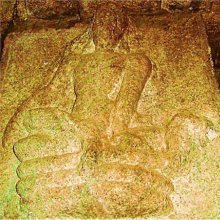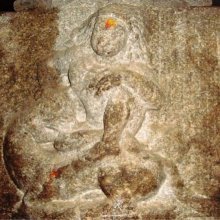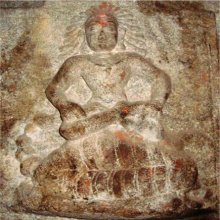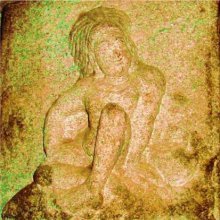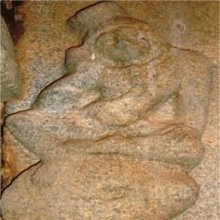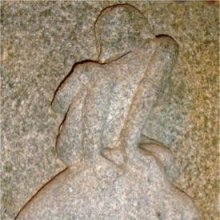Someshvara, Someśvara, Soma-ishvara: 12 definitions
Introduction:
Someshvara means something in Buddhism, Pali, Hinduism, Sanskrit. If you want to know the exact meaning, history, etymology or English translation of this term then check out the descriptions on this page. Add your comment or reference to a book if you want to contribute to this summary article.
The Sanskrit term Someśvara can be transliterated into English as Somesvara or Someshvara, using the IAST transliteration scheme (?).
Images (photo gallery)
(+11 more images available)
In Hinduism
Shaivism (Shaiva philosophy)
Source: Wisdom Library: ŚaivismSomeśvara (सोमेश्वर), one of the fifty Rudras according to the Caryāpāda section of the Makuṭāgama (one of the 28 Saiva Siddhanta Agamas).

Shaiva (शैव, śaiva) or Shaivism (śaivism) represents a tradition of Hinduism worshiping Shiva as the supreme being. Closely related to Shaktism, Shaiva literature includes a range of scriptures, including Tantras, while the root of this tradition may be traced back to the ancient Vedas.
Purana and Itihasa (epic history)
Source: Cologne Digital Sanskrit Dictionaries: The Purana IndexSomeśvara (सोमेश्वर).—Sacred to Varārohā; sacred to the Pitṛs.*
- * Matsya-purāṇa 13. 43; 22. 29.

The Purana (पुराण, purāṇas) refers to Sanskrit literature preserving ancient India’s vast cultural history, including historical legends, religious ceremonies, various arts and sciences. The eighteen mahapuranas total over 400,000 shlokas (metrical couplets) and date to at least several centuries BCE.
Shilpashastra (iconography)
Source: Shodhganga: Iconographical representations of Śiva (shilpa)Someśvara (सोमेश्वर) or Someśvaramūrti refers to one of the eight forms (mūrti) of Śiva mentioned in the Rauravāgama: the sixteenth among the Siddhāntaśaivāgamas. The forms of Śiva (e.g., Someśvara) are established through a process known as Sādākhya, described as a five-fold process of creation.
Source: Shodhganga: The significance of the mūla-beras (śilpa)Someśvara is the name of a deity depicted in the Thillai Nataraja Temple in Cidambaram (Chidambaram) which is one of the Pañcasabhā or “five halls where Śiva is said to have danced”.—Someśvara is found seated in sukhāsana posture with the right hand in abhaya and the left hand in varada-hasta.

Shilpashastra (शिल्पशास्त्र, śilpaśāstra) represents the ancient Indian science (shastra) of creative arts (shilpa) such as sculpture, iconography and painting. Closely related to Vastushastra (architecture), they often share the same literature.
Shaktism (Shakta philosophy)
Source: Google Books: ManthanabhairavatantramSomeśvara (सोमेश्वर) refers to one of the eight Bhairavas (bhairava-aṣṭaka) associated with Candrapīṭha (or Candrapīṭhapura), according to the Manthānabhairavatantra, a vast sprawling work that belongs to a corpus of Tantric texts concerned with the worship of the goddess Kubjikā.—[...] The eight Bhairavas (bhairavāṣṭaka): Ciñciṇīnātha, Someśvara, Amṛta, Śaṃkara, Trimūrti, Amareśvara, Bhārabhūti, Atithi.

Shakta (शाक्त, śākta) or Shaktism (śāktism) represents a tradition of Hinduism where the Goddess (Devi) is revered and worshipped. Shakta literature includes a range of scriptures, including various Agamas and Tantras, although its roots may be traced back to the Vedas.
In Buddhism
Tibetan Buddhism (Vajrayana or tantric Buddhism)
Source: Wisdom Library: Tibetan BuddhismSomeśvara (सोमेश्वर) is the name of a Bodhisattva mentioned as attending the teachings in the 6th century Mañjuśrīmūlakalpa: one of the largest Kriyā Tantras devoted to Mañjuśrī (the Bodhisattva of wisdom) representing an encyclopedia of knowledge primarily concerned with ritualistic elements in Buddhism. The teachings in this text originate from Mañjuśrī and were taught to and by Buddha Śākyamuni in the presence of a large audience (including Someśvara).

Tibetan Buddhism includes schools such as Nyingma, Kadampa, Kagyu and Gelug. Their primary canon of literature is divided in two broad categories: The Kangyur, which consists of Buddha’s words, and the Tengyur, which includes commentaries from various sources. Esotericism and tantra techniques (vajrayāna) are collected indepently.
Languages of India and abroad
Sanskrit dictionary
Source: DDSA: The practical Sanskrit-English dictionarySomeśvara (सोमेश्वर).—a celebrated representation of Śiva.
Derivable forms: someśvaraḥ (सोमेश्वरः).
Someśvara is a Sanskrit compound consisting of the terms soma and īśvara (ईश्वर).
Source: Cologne Digital Sanskrit Dictionaries: Aufrecht Catalogus Catalogorum1) Someśvara (सोमेश्वर) as mentioned in Aufrecht’s Catalogus Catalogorum:—poet. Śp. p. 96.
2) Someśvara (सोमेश्वर):—a writer on music. Quoted by Śārṅgadeva Oxf. 199^b.
3) Someśvara (सोमेश्वर):—philosopher. Quoted in the Raseśvaradarśana of the Sarvadarśanasaṃgraha Oxf. 247^b.
4) Someśvara (सोमेश्वर):—(?): Jaiminīyanyāyamālāvistāra.
5) Someśvara (सोमेश्वर):—Tantrāloka. Parātriṃśikā.
6) Someśvara (सोमेश्वर):—pupil of Yogeśvarācārya: Śrutaśabdārthasamuccaya.
7) Someśvara (सोमेश्वर):—
—[commentary] on Bhojarāja’s Siddhāntasaṃgraha.
8) Someśvara (सोमेश्वर):—son of Mādhava Bhaṭṭa: Nyāyasudhā or Rāṇaka or Sarvānavadyakāriṇī, a
—[commentary] on the Tantravārttika of Kumārila.
9) Someśvara (सोमेश्वर):—of Bhojapura, father of Keśava (Kauśikagṛhyapaddhati).
10) Someśvara (सोमेश्वर):—Kāvyaprakāśaṭīkā Kāvyādarśa.
Source: Cologne Digital Sanskrit Dictionaries: Monier-Williams Sanskrit-English Dictionary1) Someśvara (सोमेश्वर):—[from soma] m. Name of a divine being, [Rājataraṅgiṇī]
2) [v.s. ...] of Kṛṣṇa, [cf. Lexicographers, esp. such as amarasiṃha, halāyudha, hemacandra, etc.]
3) [v.s. ...] of a Cālukya and of various authors and other persons, [Sarvadarśana-saṃgraha; Vikramāṅkadeva-carita, by Bilhaṇa; Catalogue(s)] etc.
4) [v.s. ...] n. Name of a celebrated Liṅga of Śiva set up by Soma (= soma-nātha q.v.) and of a Liṅga at Benares, [Catalogue(s)]
Source: DDSA: Paia-sadda-mahannavo; a comprehensive Prakrit Hindi dictionary (S)Someśvara (सोमेश्वर) in the Sanskrit language is related to the Prakrit word: Somesara.
[Sanskrit to German]
Sanskrit, also spelled संस्कृतम् (saṃskṛtam), is an ancient language of India commonly seen as the grandmother of the Indo-European language family (even English!). Closely allied with Prakrit and Pali, Sanskrit is more exhaustive in both grammar and terms and has the most extensive collection of literature in the world, greatly surpassing its sister-languages Greek and Latin.
Kannada-English dictionary
Source: Alar: Kannada-English corpusSōmēśvara (ಸೋಮೇಶ್ವರ):—[noun] = Śiva.
Kannada is a Dravidian language (as opposed to the Indo-European language family) mainly spoken in the southwestern region of India.
See also (Relevant definitions)
Partial matches: Ishvara, Soma.
Starts with: Someshvara dikshita, Someshvarabhatta, Someshvaradeva, Someshvaradikshita, Someshvaraiya Upadhyapa, Someshvaramurti.
Ends with: Bhattasomeshvara, Bhulokamalla someshvara, Mimamsaka bhatta someshvara.
Full-text (+95): Bhattasomeshvara, Shrutashabdarthasamuccaya, Vararoha, Somesha, Someshvarabhatta, Someshvaradeva, Someshvaradikshita, Shodha, Arikesarin, Madhyajainendravyakarana, Somesara, Paratrimshika, Kirtikaumudi, Someshvaramurti, Siddhantavela, Mimamsaka bhatta someshvara, Someshvara dikshita, Betarasa, Bhulokamalla someshvara, Surathotsava.
Relevant text
Search found 24 books and stories containing Someshvara, Soma-ishvara, Soma-īśvara, Soma-isvara, Someśvara, Somesvara, Sōmēśvara; (plurals include: Someshvaras, ishvaras, īśvaras, isvaras, Someśvaras, Somesvaras, Sōmēśvaras). You can also click to the full overview containing English textual excerpts. Below are direct links for the most relevant articles:
The Skanda Purana (by G. V. Tagare)
Chapter 44 - Someśvara (Soma-īśvara) < [Section 1 - Prabhāsa-kṣetra-māhātmya]
Chapter 8 - The Glory of Someśvara (Soma-īśvara) < [Section 1 - Prabhāsa-kṣetra-māhātmya]
Chapter 26 - Someśvara (soma-īśvara-liṅga) < [Section 2 - Caturaśīti-liṅga-māhātmya]
Later Chola Temples (by S. R. Balasubrahmanyam)
Temples in Purisaikkudi < [Chapter XVIII - Chola-Hoysala Phase]
Temples in Tiruvanaikka < [Chapter XVIII - Chola-Hoysala Phase]
Temples in Kannanur Koppam < [Chapter XVIII - Chola-Hoysala Phase]
Middle Chola Temples (by S. R. Balasubrahmanyam)
Vira Rajendra (a.d. 1062-1070) < [Chapter V - Successors of Rajendra I (a.d. 1018 to 1070)]
Temples in Sutturu < [Chapter IV - Temples of Rajendra I’s Time]
Rajadhiraja I (a.d. 1018-1054) < [Chapter V - Successors of Rajendra I (a.d. 1018 to 1070)]
The history of Andhra country (1000 AD - 1500 AD) (by Yashoda Devi)
Part 20 - Somisvara and Mallideva III (A.D. 1157) < [Chapter XX - The Telugu Cholas (Chodas)]
Part 22 - Rajaraja I and Beta II (A.D. 1118-1129-1134) < [Chapter II - The Haihayas]
Part 51 - The Telugu Cholas of Hemavati < [Chapter XX - The Telugu Cholas (Chodas)]
The Gautami Mahatmya (by G. P. Bhatt)
Chapter 60 - Āpastambatīrtha and other Holy Centres
Chapter 104 - The Confluence of Gaṅgā with Sea
Early Chola Temples (by S. R. Balasubrahmanyam)
Temples in Tiruchchengodu < [Chapter X - Historical Survey]
Temples in Kamarasavalli < [Chapter IV - Temples of Sundara Chola’s Time]
